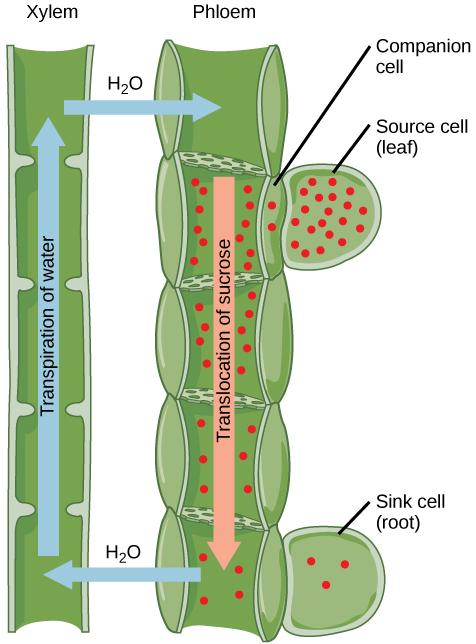
Describe the phloem transport from source to sink.
Answer
502.2k+ views
Hint: Phloem is the vascular tissue responsible for transporting sugars to sink tissues (e.g. non-photosynthetic root cells or flowers developing) from source tissues ( e.g. photosynthetic leaf cells). Phloem also transports other molecules, such as proteins and mRNAs, throughout the plant.
Complete Answer:
- Sugars that, during photosynthesis, are formed by the plant are an essential component of plant nutrition. Like water, the vascular system carries sugar (usually in the form of sucrose, while glucose is the original photosynthetic product) in all parts of the plant.
- Phloem, the vascular tissue responsible for transporting organic nutrients around the body of the plant, carries nutrient-requiring dissolved sugars from the leaves (their production location) or storage sites to other parts of the plant. Within the phloem, sugars migrate to regions of low osmotic concentration and low water pressure, called sinks, from areas of high osmotic concentration and high water pressure, known as sources.

(I) Sources: The sources are called the nutrient-rich regions that supply sugar for the remaining portion of the plant. The leaves, where sugar is generated through photosynthesis, are the sources. The nutrient storage areas, such as the roots and stems, may also function as sources when they are high in supply. Sugar is transferred to the phloem by active transport at the source, where the movement of substances through the cell membranes involves energy expenditure on the part of the cell.
(II) Sinks: Sinks, such as growing tissues, are areas in need of nutrients. Storage areas such as the cane roots and stems serve as sinks when they are low in supply. The contents of the phloem tubes flow from the origins to these sinks, where, by active transport, the sugar molecules are separated from the phloem.
(III) Pressure Flow: The process by which sugars are transported through the phloem is called pressure flow, from sources to sinks. Sugar molecules are moved into the sieve elements (phloem cells) at the sources (usually the leaves) through active transport. Water follows the sugar molecules by osmosis into the sieve elements (since water passively diffuses through regions of higher concentration of solute).In the sieve components, this water induces turgor strain, which pushes the sugars and fluids toward the sinks down the phloem tubes. The sugars are actively removed from the phloem at the sinks and water follows osmotically, so that conditions are created with high water potential and low turgor pressure, driving the process of pressure flow.
Note: In this case, the osmotic concentration refers to the concentration of solutes or sugars; when the concentration of solutes is greatest, the osmotic concentration often refers to the concentration of solutes.
Complete Answer:
- Sugars that, during photosynthesis, are formed by the plant are an essential component of plant nutrition. Like water, the vascular system carries sugar (usually in the form of sucrose, while glucose is the original photosynthetic product) in all parts of the plant.
- Phloem, the vascular tissue responsible for transporting organic nutrients around the body of the plant, carries nutrient-requiring dissolved sugars from the leaves (their production location) or storage sites to other parts of the plant. Within the phloem, sugars migrate to regions of low osmotic concentration and low water pressure, called sinks, from areas of high osmotic concentration and high water pressure, known as sources.

(I) Sources: The sources are called the nutrient-rich regions that supply sugar for the remaining portion of the plant. The leaves, where sugar is generated through photosynthesis, are the sources. The nutrient storage areas, such as the roots and stems, may also function as sources when they are high in supply. Sugar is transferred to the phloem by active transport at the source, where the movement of substances through the cell membranes involves energy expenditure on the part of the cell.
(II) Sinks: Sinks, such as growing tissues, are areas in need of nutrients. Storage areas such as the cane roots and stems serve as sinks when they are low in supply. The contents of the phloem tubes flow from the origins to these sinks, where, by active transport, the sugar molecules are separated from the phloem.
(III) Pressure Flow: The process by which sugars are transported through the phloem is called pressure flow, from sources to sinks. Sugar molecules are moved into the sieve elements (phloem cells) at the sources (usually the leaves) through active transport. Water follows the sugar molecules by osmosis into the sieve elements (since water passively diffuses through regions of higher concentration of solute).In the sieve components, this water induces turgor strain, which pushes the sugars and fluids toward the sinks down the phloem tubes. The sugars are actively removed from the phloem at the sinks and water follows osmotically, so that conditions are created with high water potential and low turgor pressure, driving the process of pressure flow.
Note: In this case, the osmotic concentration refers to the concentration of solutes or sugars; when the concentration of solutes is greatest, the osmotic concentration often refers to the concentration of solutes.
Recently Updated Pages
Master Class 12 Biology: Engaging Questions & Answers for Success

Class 12 Question and Answer - Your Ultimate Solutions Guide

Master Class 12 Business Studies: Engaging Questions & Answers for Success

Master Class 12 Economics: Engaging Questions & Answers for Success

Master Class 12 Social Science: Engaging Questions & Answers for Success

Master Class 12 English: Engaging Questions & Answers for Success

Trending doubts
Father of Indian ecology is a Prof R Misra b GS Puri class 12 biology CBSE

Enzymes with heme as prosthetic group are a Catalase class 12 biology CBSE

Which are the Top 10 Largest Countries of the World?

An example of ex situ conservation is a Sacred grove class 12 biology CBSE

Why is insulin not administered orally to a diabetic class 12 biology CBSE

An orchid growing as an epiphyte on a mango tree is class 12 biology CBSE




